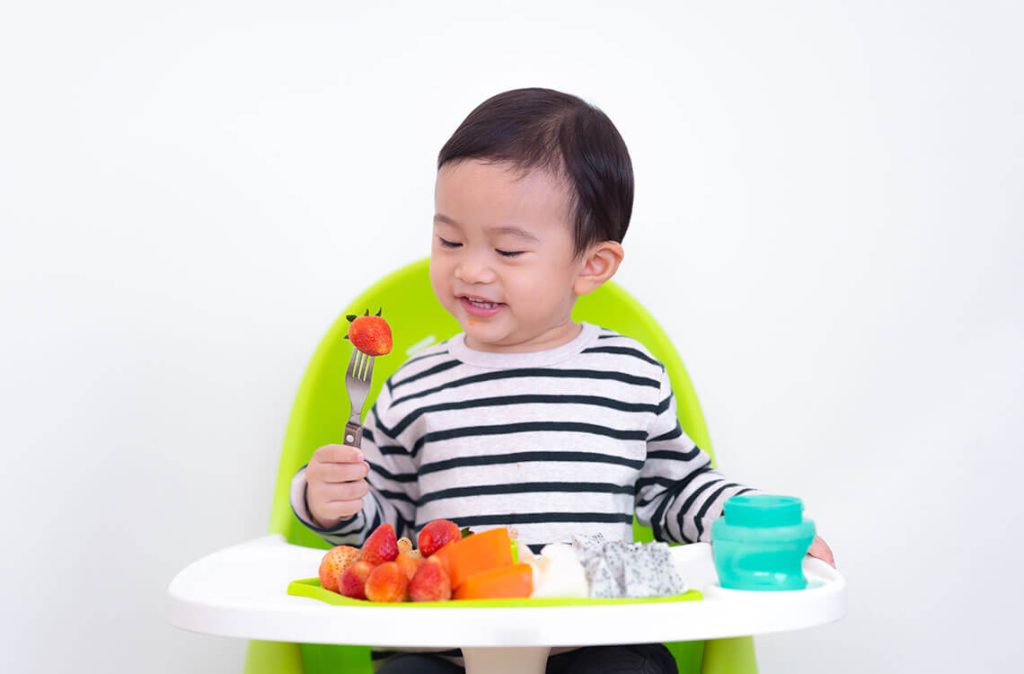Your toddler is now three years old, which means the time has come to expand and diversify their menu.
Aside from introducing new flavours and dining experiences, your child is also eating a lot more at their age. Roughly between 1000 to 1400 calories per day.
However, it’s still important to ensure they get a balance diet of protein, carbohydrates, fibre and plenty of vitamins and minerals from fruits and vegetables.
At this age, they may also have developed their own personal taste in food.
This may both manifest as a more adventurous palette, or a tendency to become a picky eater.
Here are some suggestions on what you can start including into their everyday diet.
Foods to Include
Protein
Proteins are crucial for healthy growth and development.
The amino acids in proteins are the literal building blocks for muscles, bones, organs and hormones
But not all proteins are created equal.
Opt for lean proteins which are lower in cholesterol and saturated fats.
These include fish, chicken, eggs, legumes (such as lentils, chickpeas, beans), dairy products and high protein vegetables like broccoli.
Meals that you may like them to try can be chicken curry, beef stew, meatballs and fish and chips.
If your child is lactose intolerant, plant-based proteins such as soy and tofu are complete proteins with all the essential amino acids present.
Vegetables
While you should ideally be promoting a love of veggies in your child at a younger age, there is no better than time than now.
At three years old, they are likely still very much amenable to ‘exotic foods’.
The least disagreeable vegetables include carrots, peas, spinach, brussel sprouts and potatoes.
Some of these veggies are best eaten roasted where they can caramalise and develop a lot of flavour.
When cooking vegetables this way, its best to use adequate amounts of a healthy fat like olive oil instead of butter.
Veggies don’t just supply important vitamins and minerals the way fruits do.
They also contain a lot of fibre, especially dark, leafy greens.
These are not only good for the digestive system but also has a prebiotic effect. Helping feed the gut bacteria and supporting the immune system.
Fruits
Fruits are not only rich in vitamins and minerals but also in antioxidants. Antioxidants are so important for keeping cells young and protected.
You also don’t have to take fruits too literally.
Some fruits such as grapes and blueberries can be choking hazards, so it’s best to mash or blend them up
Jams and preserves are also considered fruits, as are fruit juices and dried fruits.
These are a great way to get your kids to eat more fruits in general.
Just be sure to get those without added sugars.
Carbohydrates
Carbs are an important energy source that the body needs to function.
Of course, there are ‘good carbs’ and there are ‘bad carbs’.
But at three years old, you shouldn’t put too much of a restriction on your child.
White bread and white rice are fine when eaten in moderation.
So are pastas, noodles, pizza and indian flatbreads like chapati and paratha.
On the other hand, sugar, which is also a carb, is something that parents need to be very wary about. Due to its unassuming nature, it is easy to overeat.
After all, everything that is a carb already has sugar in it without you adding more.
Unsaturated Fats
The body needs fat for all sorts of things; energy, insulation, and yes, even growth. Your brain, for instance, is around 60% fat.
But the kind of fat you consume need to be the right kind as not all fats are the same.
Saturated fats or ‘bad fats’, increase the amount of cholesterol in the blood. This can potentially cause heart disease and obesity.
Unsaturated fats, however, are ‘healthy fats’. They are used by the body to replenish and maintain itself.
After all, many vitamins cannot be properly absorbed into the body without help of fat.
Some good fats to include in your three-year-old’s diet include olive oil, eggs, fatty fish and avocados.
When including nuts (which are rich in healthy fats) be sure to opt for nut butters or ground nuts mixed into smoothies or a yoghurt bowl.
But remember, just like with fruits, nuts can become a choking hazard for children. So, proceed with caution.
Tantalise Your Toddler’s Tastebuds
As your child grows they will slowly start to develop their own unique tastes in food.
They’ll no longer want those bland vegetable and fruit purees you once fed them but crave more adventurous and exotic foods.
As long as you start slow and allow them to enjoy these new flavours on their own time, they’ll be on their way to a sophisticated palette.
Happy munching, kiddos!
Disclaimer: The information provided in this article is for informational purposes only and should not be considered as medical advice from Mamahood. For any health-related concerns, it is advisable to consult with a qualified healthcare professional or medical practitioner.
For more insightful stories and parenting advice, stay tuned to Mamahood Singapore!
